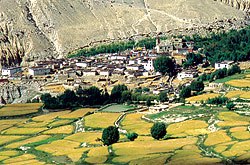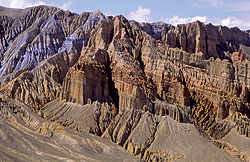 There are parts of Nepal on the Himalayan rim that are more ancient and remote than Tibet. Names of places whose names, just by pronouncing them, evoke mysticism and allure. Dolpa, Humla, Mugu and Mustang lie to the north of the Himalaya and south of the plateau. These are worlds that the world forgot. A vast wilderness of craggy, arid mountains that are neither the Himalaya nor the Tibetan Plateau--places that fell between the cracks of history.
There are parts of Nepal on the Himalayan rim that are more ancient and remote than Tibet. Names of places whose names, just by pronouncing them, evoke mysticism and allure. Dolpa, Humla, Mugu and Mustang lie to the north of the Himalaya and south of the plateau. These are worlds that the world forgot. A vast wilderness of craggy, arid mountains that are neither the Himalaya nor the Tibetan Plateau--places that fell between the cracks of history.
Here in Mustang, you can feel that remoteness like nowhere else. The silence so deep, you hear the tinkles of yak bells from across the valley as caravans make their way up a treeless, scree-filled slope. Nights are still dark, and the inky canvas of sky is perforated by tiny holes giving us only glimpses of what seems to be the blinding white light of a universe beyond. The milky way traverses the sky like a nocturnal river, and in the starlight, dry mountains and river beds gleam with a ghostly glow.
 When morning comes, the sun rises from the eastern mountains turning the lightless sky into a blue so blue that it hurts the eyes to look at it. As the valleys warm up, tufts of cumulus gather on the ridgetops and billow just like the clouds on a thangka. By noon, the wind picks up, blowing a brown and grey dust up the Kali Gandaki Valley, but in Geling it dies out and the cobalt sky remains like the colour of a dream.
When morning comes, the sun rises from the eastern mountains turning the lightless sky into a blue so blue that it hurts the eyes to look at it. As the valleys warm up, tufts of cumulus gather on the ridgetops and billow just like the clouds on a thangka. By noon, the wind picks up, blowing a brown and grey dust up the Kali Gandaki Valley, but in Geling it dies out and the cobalt sky remains like the colour of a dream.
Mustang is more remote than Tibet. Along the trails here, pre-Mahayana Bon Po shrines are more numerous than chortens and monasteries. Life still sways with animist rituals and aged ways. As elsewhere in northern Nepal, road access is changing things even in Mustang. But the roads here do not come from the south, but from the north, and with it come Chinese goods-beer, plastic buckets, rice and flour.
Inevitably, even Mustang will change as the roads bring the amenities and comforts of a new world which will replace the old. But for now the region is still uncontaminated, the isolation is still splendid, the world is still ancient. And as the pace of modernisation gathers in Tibet, it will percolate down to Mustang as well. Tourists and outsiders may lament this change, but for most of the people of the walled city of Lo Manthang this is a long-cherished dream. The challenge now is how to manage the changes that the road will bring, to ensure that rising living standards don't also bring in social evils, and how to use tourism revenue to conserve heritage and to make development more viable, minimise the destruction of the good, old ways of doing things.
So far, Mustang has coped and this adaptability bodes well for the future. Compared to a visit I made here in 1979, the villages are cleaner, the valleys are greener, tourism has brought a higher standard of living. Mustangis are growing and eating more vegetables: Mustang radish and carrots have become almost as famous as its apples. But with the bad also comes the ugly: the boxlike structures springing up on the outskirts of Lo Manthang. The snooker clubs, the gift shops that seem to contain the family heirloom of local families for tourists to buy as trophies of their travels.  Local businessmen in Lo Manthang collect orders for food and consumer items from locals and go over to the Chinese side to bring back provisions in a truck once a week: cooking gas, cigarettes, and beer. Nepali beer now costs Rs 120 while Chinese beer is just Rs 70. Tractors have come across and have speeded up the time and greatly reduced the expense it takes to make a new building. "The tractor does in three trips what 20 porters would take a whole day to do," a local contractor mining sand on the river bed outside Lo Manthang tells me. Ironically, the new buildings have beams made from Nepali timber from the Larkya area of Manaslu. Trees cut there are smuggled into Tibet, sold to Chinese merchants who bring them across and sell them back to Nepalis in Lo Manthang.
Local businessmen in Lo Manthang collect orders for food and consumer items from locals and go over to the Chinese side to bring back provisions in a truck once a week: cooking gas, cigarettes, and beer. Nepali beer now costs Rs 120 while Chinese beer is just Rs 70. Tractors have come across and have speeded up the time and greatly reduced the expense it takes to make a new building. "The tractor does in three trips what 20 porters would take a whole day to do," a local contractor mining sand on the river bed outside Lo Manthang tells me. Ironically, the new buildings have beams made from Nepali timber from the Larkya area of Manaslu. Trees cut there are smuggled into Tibet, sold to Chinese merchants who bring them across and sell them back to Nepalis in Lo Manthang.
There are only a few signs that this is Nepal: the boards in Nepali at the post office, the customs post and the village development committees along the way. There are bahun and chhetri teachers in the schools, and the big change in the past 30 years is that almost everyone now speaks Nepali. Along the trail we run into a Tamang from Dolakha who has lived here and married a Mustangi woman. They run a chhang and tea shop and speak to each other and with their customers in Nepali.  Now that the Lo Manthang road is finished, along the trail from Jomsom to the north, every village along the way that has lost out to the trade wants to build a road north along the Kali Gandaki. Some, like the village of Charang, have started digging their section. At this rate, Jomsom will have a road to Tibet before it has a road to Baglung. Tractors and jeeps have already arrived in Jomsom, brought over in the belly of Russian helicopters and used for hotel transport and for construction.
Now that the Lo Manthang road is finished, along the trail from Jomsom to the north, every village along the way that has lost out to the trade wants to build a road north along the Kali Gandaki. Some, like the village of Charang, have started digging their section. At this rate, Jomsom will have a road to Tibet before it has a road to Baglung. Tractors and jeeps have already arrived in Jomsom, brought over in the belly of Russian helicopters and used for hotel transport and for construction.
The road is obviously going to follow the old trading route, transforming the landscape and the way of life of this ancient trail. Luckily, there are alternative routes up and down from Jomsom to Lo Manthang that can still be used for trekking when the highway is finished. The side roads are even more remote and forgotten than this remote and forgotten part of Nepal-places with names which would be great names for male deodorants, like Dakmar on a side-valley near Charang.
Jomsom is now a much-cleaner version of Thamel, even Muktinath has become cosmopolitan, boasting a Bob Marley Caf? Shop and Restaurant which has Buffalo Soldier blaring out on to the streets where Indian holy babas straggle along towards the temple with the eternal flame.
For now, before the road is completed, the Mustang trail follows a circuit with some spectacular smaller valleys that are worth exploring. An ideal itinerary after flying into Jomsom from Pokhara would be as given on the box (right).
North of Kagbeni, tourists (except Indians) need a special permit that can be obtained from the Home Ministry by paying a fee of $700 for 7 days, and $170 for every extra day. A bit steep, but believe me, for a trip of a lifetime, worth every cent. Most of this can be arranged by some of the more reputable trekking agencies in Kathmandu. Indians and Nepalis do not need any special permit, but it is better to carry a citizenship certificate or a passport just in case you get stopped


